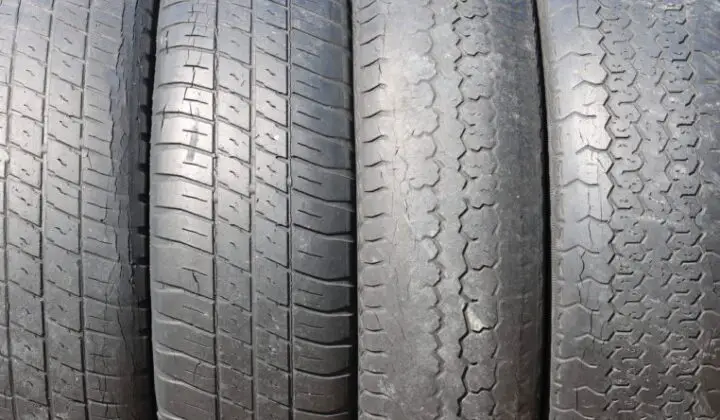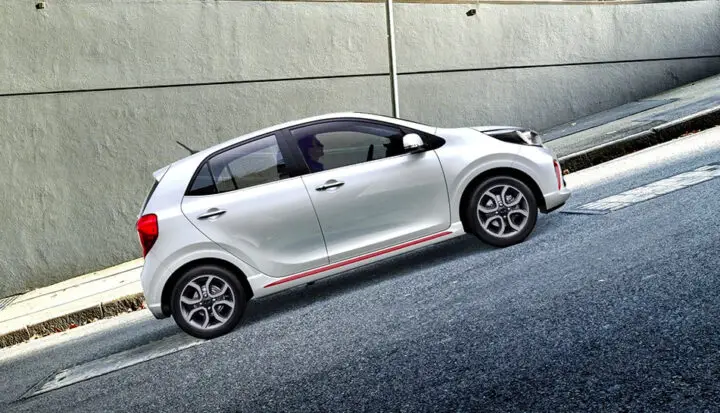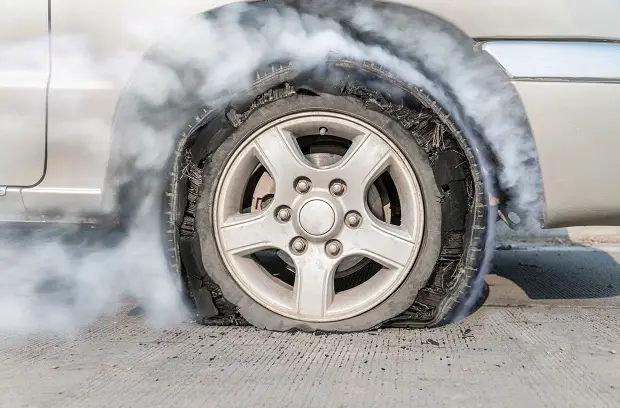Tires are one of the most important aspects of your vehicle. They provide a connection between your car and the road, which is essential for safe driving. As you drive over miles and miles, they can wear out fast due to a variety of factors. In this blog post, we’ll cover some common causes that lead to tire wear-out!
First off, let’s talk about where tires get worn down from: mainly from high heat or low air pressure in the tire. If you have ever seen smoke coming from under your car when it was parked on hot asphalt during summertime, chances are good that one or more of the tires has low air pressure in them.

Low air pressure will cause faster wear because there is not enough “cushion” in the tire when it is driven. This leads to more heat being generated during turns and cornering, causing even faster wear. It can also lead to a blowout if you don’t have enough air pressure in your tire to allow proper inflation of the side walls – which typically carries most of the load when your vehicle is going down the road.
Table of Contents
What Causes Tires To Wear Out Fast?
There are many things that can cause your tire to wear out quickly. If you’ve ever had a flat tire, then you know why it’s important to check them regularly and keep them properly inflated.
There are four main reasons which tires wear out quickly:
- Driving habits
- Weather conditions
- Tire pressure
- Incorrect tire size
When buying a new set of tires, you should consider all four factors. The right tire will have the best tread life and keep you safe on the road.
1. Driving Habits
Tires wear out quickly when you drive too fast or aggressively. Aggressive driving includes taking turns fast, making sudden stops, and not slowing down for potholes.
2. Weather Conditions
Snow tires last longer than all-season tires because they have technology that improves their traction in cold temperatures and wintry conditions. This makes the tire more resistant to wear and tear during braking and acceleration.
Tire tread life depends on the weather conditions where you live. If you live in an area that’s prone to snow or heavy rainfall, then it’s best to invest in winter tires or all-season tires which are more resistant to wear and tear.
3. Tire Pressure
Driving with low tire pressure will wear out your tires quickly and compromise their traction and ability to grip the road. Tire pressure is the second biggest cause of abnormal tire wear according to the Bridgestone/Firestone study. If you maintain proper tire pressure and drive carefully, they should last for around 45,000 miles.
4. Incorrectly Sized Tires
If you have an incorrect size, it can cause abnormal wear on your tires which may result in an accident. Tires should be replaced when they get worn out. If you have an incorrect size, it can cause irregular tire wear which may result in an accident or failure of your vehicle’s suspension components.
5. Driving Habits
Driving habits are the biggest cause of abnormal tire wear according to the Bridgestone/Firestone study. If you keep your tires inflated to their proper pressure and maintain good driving habits, they should last for around 60,000 miles.

Do Front Or Back Tires Wear Out Faster?
Front tires wear out faster than back tires because most of your braking and accelerating force is applied on the front axle. They also bear more weight and handle more stress than back tires do which can cause them to wear out faster.
Front tires wear out faster than back tires because most of your braking and accelerating force is applied on the front axle. They also bear more weight and handle more stress than back tires do which can cause them to wear out faster.
Front tires in a front-wheel car wear out faster because they are more use out of them from the power distribution from the engine. This huge amount of effort, energy, and inertia placed on the front tires causes them to wear much faster than the free-spinning rear wheel tires.
Why Do New Car Tires Wear Out So Fast?
New tires wear out quickly because the rubber is not yet “bedded in” and is stiff. It takes around 2,000 miles or so for tires to become more flexible and grip the road better which gives them a longer lifespan. Most tire manufacturers warranty their tires for about 12 months too which offers additional peace of mind when you buy them.
Who has a vehicle that requires regular tire changes, such as every few thousand miles, maybe wasting money? The tires are not necessarily always wearing out prematurely. People tend to buy new tires when the tread is only down by one or two millimeters, depending on their driving habits and road conditions. While low tread depths can mean a replacement is needed, it is the driving habits and road conditions that will often cause them in the first place.
Driving on fast-moving highways puts a lot of stress on the treads in the tires, causing them to wear out faster than when used for local driving at lower speeds. Furthermore, if people aren’t checking their tire pressure regularly, they are probably using more gas. Even if the tire pressure is accurate, it can vary depending on weather conditions that impact how much air gets into the tires.
Tires are not built to last forever. The materials used in them are less sturdy than those utilized in most other car components and also break down over time due to environmental factors such as ozone, heat, and sunlight. If a vehicle is not being used for its intended purpose, such as being parked in the garage while people are at work or on vacation, then it results in tires wearing out more quickly than they would otherwise.

How Do I Know If My Tires Are Worn Out?
The best way to know if your tires are worn out is to check the tread depth. Treads should be at least 4/32 of an inch deep when new and never less than 2/32 of an inch, according to Tire Rack. If they are in that range, then there’s no reason for replacing them unless you want a different style or brand.
While tread depth will eventually wear down due to normal use, it can change much faster depending on road conditions and usage habits. When the tire is worn out, there are typically other signs before the treads are completely gone.
If your car starts pulling to one side or if you hear screeching when turning corners, that’s a sign that the treads are thin and need replacing. Also, if the tires start to look flatter than usual, then they’re worn out as well.
Is It Normal For Tires To Have A Worn Look?
No, it is not normal for tires to have a “worn” look. If your new tires already look like this, especially right after you’ve had them installed, then it means the dealer or installer may have used old tires as a replacement. It is unprofessional and can be dangerous because old tires are not as resilient as new ones.
Also, if your treads appear worn down unevenly or you see bumps and lumps on the surface, it may be a sign of poor manufacturing or installation. No matter the reason for your tires looking worn out, make sure to check with your dealer before driving on them. You don’t want something potentially life-threatening happening due to improper care.
How Long Do Steer Tires Last?
Although road conditions do play a role in how long tires last, the most important factor is how they are cared for. As stated above, regularly checking the tread depth and tire pressure can help extend their life by several years. Not only does this ensure that motorists get the most out of their investment, but it also gives them peace of mind while driving.
More than 20 million tires are replaced every year in the United States. If everyone checked their tread depth and tire pressure on a regular basis, there would be fewer traffic accidents and fatalities both on highways and side roads. It also would save people money because they would extend the lives of their existing rubber instead of buying new ones prematurely to replace the old.
The tire industry is an important part of the automotive community and economy in general. That’s why it’s important for everyone to know how and when to replace worn tires instead of allowing them to remain on their vehicle until they fail. As long as drivers check tread depth and tire pressure regularly, they can minimize wear by several years while driving with a lot more safety and comfort.

When Should Steering Tires Be Replaced?
How well a car steers is largely dependent on the tires. If they are too worn, then it can cause several problems with the handling and direction of a vehicle.
Tires do not last forever, but motorists should check them regularly to make sure that they are in good condition before driving. In addition, to tread depth and tire pressure, motorists should check for bulges, bubbles, or lumps that could be signs of poor manufacturing.
If the treads are completely gone and show no sign of being able to hold air, then it’s time to replace them together. If they have some tread remaining but are worn down unevenly, then they only need to be replaced on one side.
Is It Safe To Drive On A Tire With Less Than 10/32 of an Inch Of Tread?
Driving on a tire with less than 10/32 of an inch is not recommended by car experts because these tires are worn out. Most states have laws that motorists should replace their worn-out tires to avoid accidents caused by car failure.
If you are having problems with your tires, then contact an automotive service center like Auto Plus for more information and assistance.
Main Takeaways – What Causes Tires To Wear Out Fast?
With so many factors to consider when it comes to tires, there are certainly some things you can do to prolong the life of your tire. From driving habits and pressure levels, all the way down to what type of surface you drive on most often. But no matter how much care we put into our vehicle maintenance routine, at some point they’ll need new rubber just like any other part that wears out over time or with use.
Heavy vehicles, such as trucks or buses, can cause a lot of friction on the treads which could lead to quicker tire wear. This is because heavy vehicles tend to use their brakes more often than lighter ones like passenger cars do – this puts stress on your car’s brake system and also wears down the items in it that are used for braking.
Brake pad material will naturally break down over time due to exposure from heat generated during prolonged periods of driving with hard braking, so you’ll want to replace them every 50-100 thousand miles if they’re not already aftermarket parts made by a third party manufacturer specifically designed for longer service life intervals.
